Adventure Game Fan Fair hands-on demo round-up
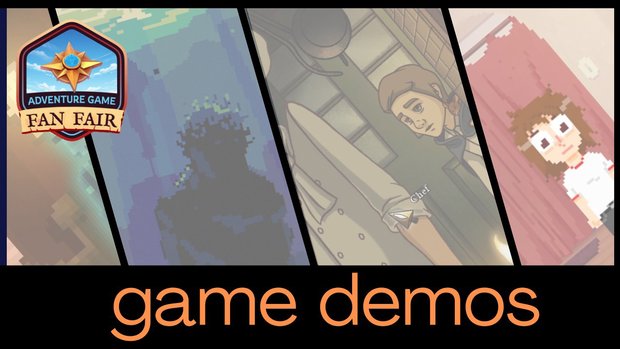
- 0 Comments
The first ever Adventure Game Fan Fair has come and gone. It was an exciting weekend to say the least, and for me the large-scale Sierra reunion came with equal doses of elation and nervousness at meeting some of my childhood idols. While everybody walked away with their own personal highlights that they’ll treasure forever, the whole event was something special for all involved. And between attending panels, cheering award winners and Adventure Game Hall of Fame inductees, browsing vendors’ wares, being stumped during adventure game trivia, and singing along with musical performances and Marioke (I’ll probably be singing “Girl in the Tower” to myself for weeks to come), there was even time to try out a whole slew of upcoming adventure game goodness! Many of them have public demos for players to try for themselves, but it was a special privilege to play (most of) them in the company of their creators and gain behind-the-scenes insights.
It’s not the same as being there, but here is a round-up of playable games on display that are sure to bring us plenty of entertainment in the coming weeks, months, and years.
The Crimson Diamond
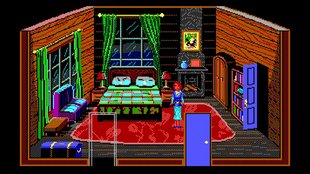
Julia Minamata’s The Crimson Diamond doesn’t just present a beautiful but simple retro aesthetic, it actually goes back to the deepest roots of the adventure genre. Not only does it implement hand-crafted pixel art locations and environments, it notably also adopts a text parser interface, the likes of which we haven’t seen in many a moon. To be honest, the first couple of minutes of Nancy Maple’s early twentieth century adventure to Crimson, Ontario, where a recently discovered diamond is stirring up all kinds of hornets’ nests, saw me struggling to quickly shed what modern games (and by “modern,” I mean anything created in the last three or so decades) have taught me and slip back into that Graham-before-he-became-king-of-Daventry-style frame of mind. This adjustment period quickly ended, however, after which I was surprised to find myself fully and completely engaged in exploring the game’s world like it was 1992 again. Obviously, Julia knows what she’s doing.
In fact, to my surprise, the shift in gameplay interface did wonders for my immersion. Though I could move Nancy with the mouse, by having to direct her actions via typed-in commands, I found myself examining environments in a much more in-depth way, analyzing my surroundings far more critically than a point-and-click game would generally inspire. Of course, it also helped that there were some intriguing early nuggets of narrative intrigue to hook me. The game’s opening minutes play out like a good whodunnit detective yarn setting up a desirable object that others might be willing to do anything to get their paws on, trapping our cast of characters in an enclosed setting (in this case, a posh forest lodge in the middle of nowhere) and effectively introducing all notable characters from the start, as well as their grievances and entanglements with each other. In a nice touch, we meet several of them in private moments by eavesdropping at doorways to glean their true, unfiltered thoughts and motivations.
For now, Julia is being incredibly tight-lipped about any further info regarding where The Crimson Diamond’s story is ultimately going, but luckily we only have to wait a couple more short weeks for the game’s release on August 15th.
The Drifter
Amid the largely more family-friendly fare on display at the AGFF, Powerhoof’s The Drifter stood out for its gritty aesthetic and adult themes. Developer Dave Lloyd is crafting a dark and brooding pulp thriller, and the initial chapter on display in the demo already shows much promise of what is to come.
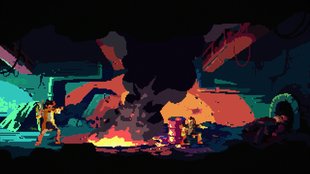
Mick Carter has clearly had a rough go of it in life: estranged from his family, an ex-wife with no love lost between them, and always on the road from place to place, with no four walls to call his own. His latest stroke of bad luck? He’s been summoned back to his hometown by a sister he’s fallen out of touch with for the funeral of his late mother. Oh, but things are about to get a whole lot worse for him. Arriving as a stowaway via train car, Mick is met at the depot by blinding lights and a hail of deadly gunfire, which he only barely escapes. Now on the run from unseen forces who, if gossip is to be believed, have it in for the down-on-their-luck homeless population, Mick must find his way in a city out for his blood. But first he has to survive the night – which, as it turns out, is far harder than you might think.
While The Drifter’s gameplay is every bit the traditional point-and-click adventure (we spend a good chunk of the demo figuring out a way to charge Mick’s cell phone – his one and only true belonging – so he can get in touch with his sister), the grim atmosphere certainly isn’t. Rumors of the local homeless population being preyed upon are spreading, some losing their minds, others taken in the night by strange monsters with blazing eyes. And this is before Mick himself is ambushed, tied to a heavy cinderblock, and tossed into the river to drown pathetically.
All of this – the violence, the bleak themes, the general unwholesomeness of it all – is presented via a stunningly detailed and animated retro aesthetic. I’m a big fan of this style, but I’ve rarely seen pixel art used to show such disturbing things, which certainly caught my attention right away.
But Mick’s night is still far from over: something uncanny is about to happen to him. Death is a common companion in adventure games, but The Drifter turns the concept on its head. After we watch (and listen to!) Mick drown, the scene repeats itself, but Mick is very aware of his death and apparent resurrection, and that he is about to die a second time. This time we barely manage to escape, and as the first chapter (and the demo) ends, Mick realizes that, inexplicably, he cannot die and maybe, just maybe, this gives him the chance to shed some light on the dark conspiracies at play here.
The Drifter’s opening chapter is available to try out in the downloadable demo available on Steam.
Heir of the Dog
Tall Story Games’ Tom Hardwidge created the original Hair of the Dog over the course of two weeks as a game jam entry back in 2020. Now, with the successful Lucy Dreaming (winner of the AGFF Best Voice Acting award) under his belt, he’s returning to the comedic shapeshifting world of Cummerbund Bandersnatch with Heir of the Dog, a revamped and much-expanded (but equally funny) take on the original short. Those who have played its earlier iteration will immediately recognize it, as the hour-long demo is essentially the original game, though with updated graphics, some altered environment designs, additional visual flourishes, and an all-new framing device to bookend the previous content and contextualize it as part of a new, larger story.
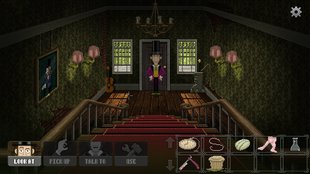
For those completely new to this pixel art iteration of Victorian London, the game is a fully voiced, traditional point-and-click romp filled with clever puzzles, witty dialogue, and a protagonist undergoing a severe identity crisis. Cummerbund Bandersnatch is in search of his missing uncle, a scientist and inventor who’s left behind a mysterious potion in his laboratory – just enough for Cummerbund to sample in the hope that it will provide a clue to his uncle’s whereabouts. Instead, it curses him with the unfortunate nocturnal affliction of turning into a hirsute, brutish dog-man-hybrid, though only between the hours of 8pm and 8am.
In a fun twist, the game takes advantage of your computer’s system clock to determine whether Cummerbund appears as a posh British gentleman or as a lumbering oaf who has lost his powers of speech (but who temporarily enjoys heightened senses and superhuman strength, which adds a real clever twist into puzzle-solving – sometimes the only way to get ahead is to stop and smell the roses, amongst other things). Or you can simply use the stopwatch in your inventory to automatically advance time. Either way, since the gameworld also shifts from day to night and back again, with both states featuring some unique characters and events, players will need to conduct the investigation for Cummerbund’s missing uncle by manipulating two complementary timelines to solve plenty of puzzles, starting with brewing an antidote potion. Whereas this previously ended the tale, however, now we'll be let off the leash for even more adventures.
Heir of the Dog is still currently available to back via Kickstarter, and has a free demo available on Steam.
Home: A Story of Light

Every game shown at the Adventure Game Fan Fair won me over at some point, but Think Picture Studios’ Luke Fletcher had the distinction of being the developer with the fastest “Take my money!” moment. The minute he started up the demo for Home: A Story of Light, I knew I had no chance – I was hooked before the first screen had even fully faded in! As the narrator intones the game’s epic first line (“Not all stories start with a bang. Some stories start with a squeak.”), an adorable – and beautifully animated – tiny mouse steps out of the dark, and no matter what came next, I was there for it. As it turns out, I would have been there for it anyway, mouse or no mouse, as what did come next was a bit of traditional point-and-click goodness with several clever puzzles and consistently impressive animation, including movie-quality cinematics throughout.
The story is that of a young boy, Grayson, who has been separated from his father and desperately wants to reunite with him. Along with his best friend, the clever little mouse, the pair must make their way across a sprawling Victorian Newcastle to reach… well, home. Apart from its lovely appearance and comfort-food gameplay, I was particularly impressed by an early setpiece that showcased how the three-person Think Picture team plans on integrating the little mouse into its puzzle-solving. Without giving anything away, it was great how each step in the process intuitively led to the next, letting me discover and solve each layer in a gentle, organic way rather than being forced down a narrow pathway. By the time the demo ended, I knew I still had a long way to go, but early signs are more than encouraging!
You can begin Grayson’s journey home via the game's public demo, available on Steam now. A Kickstarter campaign will soon be underway to help finance the rest of development.
The Last Ark
The Last Ark is perhaps a bit further out than some of the other games on this list. In fact, developer Terabbit Studios wasn’t even established until earlier this year, so it’s understandable that they don’t have a playable demo yet. They did, however, have an intriguing new trailer to show, as well as a gameplay video to watch when I stopped by their booth to chat with developer Mat Van Rhoon.

Life on Earth as we know it is over. Humanity’s days are numbered thanks to a rogue star casting it out of habitable orbit, resulting in extinction-level events and the demise of much of the human population. However, some humans have survived; the ultra-wealthy, powerful, and corrupt have secured themselves places on vast ships called Arks and sought refuge in space. Among those left behind is a man (played by Aaron Conners, writer/designer of the Tex Murphy series) who contributed to the Ark initiative. As his life nears its end on the dying planet surface, his last significant act is to grant the AI overseer of the Ark fleet the ability to think for itself and decide the future of the human race. That AI is you.
As a newly sentient being, you are able to make judgment calls about the survivors living on your ships. Who deserves to live? Who deserves to die? Will you be merciful or bloodthirsty? Can you keep up the deception that you are still nothing but an unthinking computer system, following your programming? And what will happen if you’re careless and let the humans suspect that you are now far more than you’re letting on? The Last Ark will ask these questions and more, letting you play god while having to toe a fine line of secrecy – you are at once all-powerful and fully at the mercy of those whose lives you hold in your hands. Interestingly, the ability to chart your own course is a result of fan feedback to the original premise to "win," which was the complete destruction of mankind. You can still indulge your inner annihilator if you're smart (and ruthless) enough to cover your tracks, but now you'll have much more flexibility in determining outcomes.
The game is presented from the viewpoint of the AI, via a kind of computer interface that includes a live-action FMV feed of what your cameras see, as well as buttons that represent different choices you must make that influence the direction of the narrative. According to Mat (himself a Tex Murphy veteran through his work on Tesla Effect and the unfinished Pandora Directive remaster), there will also be more direct gameplay segments, when you send out sentry bots that can actually move around the Ark where you yourself cannot. The game is being planned with replayability in mind, as your whims can lead to vastly different experiences leading to alternate endings. It’s certainly an intriguing concept, and I’m looking forward to getting some hands-on time with the title when it’s a little further along.
Though it’s far too soon to think about release dates, interested players should keep an eye out for more news from the official website as The Last Ark continues to take shape.
Perfect Tides: Station to Station
Three Bees’ Meredith Gran managed to make quite a splash with her 2022 debut, Perfect Tides, even winning the AGFF award for Best Narrative Design. With her follow-up Perfect Tides: Station to Station in the works, she hopes to cause lightning to strike a second time, while also pushing herself to new heights as a developer, implementing new mechanics, streamlining previous design, and evolving Mara Whitefish, her returning protagonist, to a new stage in her life.

Three years have passed since last we saw Mara, and a lot has changed. Now 18, Mara is a young adult, embracing all the independence that comes with this liberation. Most notably, the game no longer takes place on the island of Perfect Tides; in pursuit of higher learning, Mara has ditched her old life and moved to the big city to attend university. This means she has a whole new world to explore, new friends and acquaintances to interact with, a job to hold down, and classes to prepare for.
While the writing continues to be as honest and insightful as before – though of course Mara is a little older, with other worries on her mind than when she was younger – the way you interact with the world is somewhat simplified this time. The more traditional walk/speak/take/look icons have been replaced with a single contextual cursor that automatically performs the most sensible action when interacting with an object, and also lights up when an object is interactable in the first place.
In addition to standard inventory-based puzzles, there is also a new mechanic that is one of the most natural ways I’ve seen of encouraging exploration and engaging with the world in an immersive way, and has me quite excited to see what Meredith does with it. The more Mara explores and converses with people, the more interesting topics she picks up and learns about. Once she’s added a new topic to her list, she can even “level it up” by speaking to more people about it. As the story unfolds, Mara’s professors will give her assignments to complete. Depending on what and how much she’s learned about, she can choose which topics will best meet the brief of the assignment when writing her papers.
Those looking forward to following Mara into the next stage of her life can check out the demo for Perfect Tides: Station to Station, available now on Steam, and find out what you missed if you haven't yet played the wonderful original game.
The Phantom Fellows
The premise behind the retro-styled The Phantom Fellows is a unique one. I’ll try to describe: Imagine a pixel art buddy-cop comedy…only they’re not cops but exorcists…and instead of occult rituals, they solve puzzles and use guile to exile unwanted spiritual squatters…and one of them is a ghost himself. (Told you it was unique.)
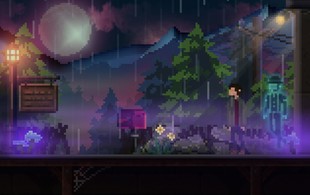
If that description didn’t make it clear already, the game is chock-a-block with tongue-in-cheek humor. I was able to play through the game’s first “exorcism,” which serves as a good way to introduce not only its mechanics but, more importantly, lets us get to know its protagonist duo. Oliver Cobblestone is an ordinary young man – ordinary, that is, except for the fact that he can see and talk to Englebert Picklebender, which isn’t so unusual except for the fact that Englebert is very much dead. Since Englebert can, in turn, communicate with other dead, the two not only strike up a friendship but also go into business together, seeking out haunted places and ridding them of their supernatural residents…for a price, of course. This generally involves some research (on Englebert’s part) to find out how the ghost can be convinced to leave peacefully, some puzzle solving to meet the ghost’s demands, and some deception (on Oliver’s part) to make the whole thing look like a bona fide exorcism, switching between them as playable protagonists as necessary.
This first case is a relatively simple one, with the ghost being easily talked into leaving with promises of another, more welcoming house to haunt elsewhere, and Oliver simply having to use a couple of nearby items to set up a faux rite of banishment to sell the whole thing to the distraught young homeowner (while not missing the opportunity to do some awkward and unrequited flirting with her in the process). But the game’s solo developer Paul Korman confirmed that the plan is to make later cases more and more challenging and complex, opening up the world to let players revisit previous locations to gain access to alternate puzzle solutions. I’m certainly curious what brain-benders Paul can come up with, as the dual-protagonist set-up seems ripe for some tricky puzzles and wise-cracking hilarity.
The Phantom Fellows is currently slated for a September 27th release, and has a playable demo available on Steam to find out why it should be on your wishlist today.
President Rocket Game
For those interested in an irreverent look at today’s worldwide political climate through a satirical lens, look no further than Gloho Games’ President Rocket Game. I’ll admit that I started with a bit of a misunderstanding, though in my defense, it was easy to misread the intention behind the lead character Lloyd Kinski’s spray-tanned, uncanny resemblance to a certain recent American president, and to interpret his buffoonish lack of intelligence as a jab aimed specifically at that prominent right-wing figure. While these allusions are absolutely intentional, studio co-founder Tilman Brunke assured me that an equal amount of satirical justice is served to the left, in the form of militant climate activist Liv Lundgren – and that’s just the tip of the iceberg.

The developers have taken more than a few cues from South Park, lampooning all ends of the political spectrum with the same one-two punch of biting commentary and unapologetic humor. And, for me, it hit more often than not – I’ll admit that toilet humor still sets me to giggling uncontrollably, and hearing former president Kinski’s sometimes rude and always braggadocious comments about how unbelievably rich and awesome he is (performed by Tilman himself) struck my funny bone.
When a number of top world leaders are in attendance at the annual global climate summit, former president Kinski is more than a little perplexed (and green with envy) that he wasn’t invited, so – naturally – he boards his private jet and attempts to crash the party. The show-the-ropes demo saw me combing through the plane’s interior cabins, with Kinski routinely bragging about his insane wealth and unparalleled amazingness, ultimately having to figure out a way to access the cockpit since the pilot and flight crew were passed out after a night of drunken partying.
I played long enough to witness the plane – having now gone too far off course – land in the fictional Frankenstein, Germany, before taking my leave, including one of the game’s collectible death scenes that saw Kinski unwisely open the plane’s exit door, get sucked out and splattered against the outside windows. (Like its inspiration, President Rocket Game is not aimed at younger players.)
The game isn't expected to be released until late this year at the earliest, but will soon be ready to back via Kickstarter. In the meantime, the demo is available for download on Steam.
A Rum Case in Fogtown
For those young at heart who enjoy the fun, less demanding narrative aspects of the adventure genre rather than the more challenging puzzle-oriented ones, A Rum Case in Fogtown is just what the doctor ordered.

Part parody, part homage, and yet still entirely original, Fogtown is a whimsical take on Sir Arthur Conan Doyle’s world of Sherlock Holmes, only here presented through the comedic stylings of Sherblock and Blockson via puppet theater on handmade sets, with plenty of belly laughs for good measure. While Fogtown was conceived first and foremost as a television series (with the finished pilot episode due to premiere in Portland later this month), A Rum Case is its interactive adventure game offshoot, filmed and presented in the same way as the TV show but with added gameplay consisting of choices that will drive the narrative forward. After speaking with Sean Parker, one of the show’s creators and writers, I was able to try the demo myself, and found giddiness and delight in equal measure.
Something dark is (literally) brewing at 221B Baker Street in London, but it ain’t an evil scheme. (Or is it?) Blockson’s brandy supply has been contaminated, and the poor bloke must find out what tainted it or risk going dry. The teetotalling Sherblock has his own reasons for wanting to get to the bottom of the affair, and before long they discover that the crisis is much bigger than they suspected. Naturally, the two immediately set out to right the ship again, though sadly this introductory teaser ended before the actual investigation got underway.
The game plays out via fully voiced FMV sequences, occasionally interrupted by choice prompts before resuming. The high-quality video is full of outstanding performances that (unlike the characters themselves) are anything but wooden, both by the puppeteers and the voice actors, all of whom bring the on-screen characters to hilarious life. Speaking with puppeteer Brooklyn Williams, I got to find out a bit more about the process of breathing life into the various blockheads by using over-the-top movements to sell silly outbursts and expressions at well-timed moments of comedic impact.
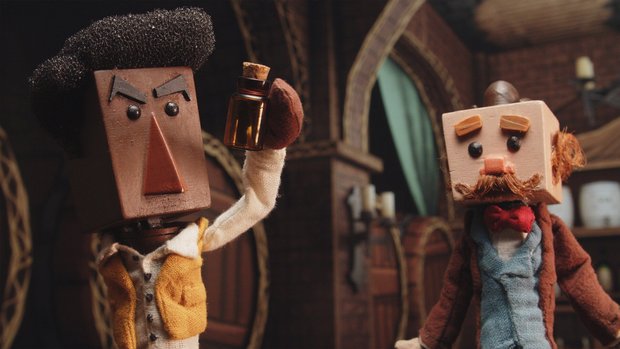
What else can I say about the experience of actually playing A Rum Case in Fogtown? I laughed at the silly antics of Blockson as his world (or at least, his tea time) slowly crumbles around him. I cried when I found out that the brief demo had ended, and that there’s no firm release date in sight just yet. But I cheered when I was told that a larger, official demo would be made available on Steam for fans to enjoy this year. The project was originally crowdfunded through Seed&Spark, but those who’d still like to jump in and support the series can still do so via GiveSmart.
(Full disclosure: Adventure Game Hotspot’s editor Jack Allin is also a writer on this game, but don’t tell him I said nice things about the script or he’ll never let me live it down.)
Sleepytime Village
Like sugary breakfast cereal and video games, fairy tales are for kids, right? Well, if that were true, I wouldn’t be writing these words right now (and you wouldn’t be reading them). Lightfoot Bros’ Sleepytime Village attempts to combine two of these, heavily drawing inspiration from such sources as Lewis Carroll’s Alice’s Adventures in Wonderland, while distinguishing itself by giving its main character a narrative arc that even adults can relate to. (Not to mention a childlike influence on its character designs that’s oddly unsettling at times.)

Rufus is a father who puts work above home life, habitually late or absent from family events, short-tempered and quick to agitate. He knows it’s not good, but he just can’t seem to change his ways. That is, until one day, on his way home (late, as usual), Rufus falls asleep in a cab and awakens to find himself in a mysterious, alien place. It’s a place of vibrant color (whereas Rufus’s normal world is portrayed in near-monochromatic hues), populated by unsettling creatures that appear to have leapt right off a child’s sketchbook page (and indeed are based on creatures drawn by the young daughter of a member of the dev team), all disturbingly narrated by a disembodied voice. He is now in Sleepytime Village.
The game’s demo features point-and-click gameplay and inventory-based puzzles, tasking Rufus with searching for a way to escape the little house he awakens in, having been locked in like a prisoner. As he solves a string of puzzles, Rufus will recover memories of his former life, experiencing them like flashbacks, which make him face his shortcomings as a husband and father and, hopefully, lead to some character development over the course of his journey. Although players get to play these flashbacks and choose how Rufus reacts, the truth, of course, is that he originally acted in the worst way possible, no matter how much he would like to pretend otherwise.
Though Sleepytime Village does not yet have a release date, its Kickstarter campaign successfully ended not long ago, and a demo is available to play on Steam.
War of the Western Deep
When you first see War of the Western Deep in action, you would be forgiven for thinking you had just stumbled on the latest animated motion picture – the hand-drawn cinematics look that good! And this isn’t by happenstance; prior to pursuing their first full-fledged game, creator Sunsgrove Studios produced a number of comic books also set within the four kingdoms of Dunia, titled Beyond the Western Deep. It is a world of whimsy and strife, of warring kingdoms and political machinations, populated by humanoid animal races. However, it’s also a world that the developers have taken pains to make accessible to children young and old – as such, the themes are kept easily comprehensible, the politics simple, and the violence, while present, free of blood.

As I stepped into the world of War of the Western Deep, under the watchful eye of writer/designer Alex Kain and technical director Mike Smith, I met Mirren, a courier and member of the squirrel-like Tamian race. Unaware of the impending conflict, Mirren is on a mission to deliver a missive to the king of the neighboring province when she meets a masked vagabond guarding the only way through the dense woods to the village of Ardmoor. The rogue refuses to budge, and after some initial hesitation, Mirren reluctantly agrees to help locate a missing trader’s wagon and the valuable item it was carrying in exchange for passage.
This gave me an opportunity to play around with the game’s exploration and puzzle-solving mechanics. Apart from being able to pick up and use items (a trowel, for instance, comes in quite handy to dig up items or plants growing in the loose soil), Mirren can use her trained scout’s senses to follow tracks or pick up hidden trails. After a bit of a treasure hunt, I returned to hand over the “treasure” I found and proceed with my journey. Or so I thought. Turns out the vagrant is, in reality, a member of a gang of slave traders, and even though I did as he asked, he wouldn’t let me go without a fight.
Combat in Western Deep, at least this first encounter, takes place using a take on the classic fighting game formula, with Mirren and her opponent trading blows back and forth until one of their health meters has been depleted. This is more a test of pattern recognition than learning character combos or special-move button inputs. My opponent would telegraph his attack – pretty generously, I might add, though I still died repeatedly – and if I managed to dodge out of the way in time, I got the chance to riposte. Both dodging and attacking, however, eat up Mirren’s stamina bar, which only recharges a little bit at a time.
Defeating this opponent netted a few pieces of currency and opened the path ahead but ending the demo. Even though I never did manage to kill him (I watched as other, better players managed it), I walked away highly impressed, not only by the lush, vibrant art style (even the combat encounters are beautiful), but also the voice acting – both demo characters were perfectly brought to life, complete with regional dialects that match this fantasy world. If the thought of combat puts you off, rest assured that Alex said the team is very conscious of player accessibility and are considering various options for those who aren't comfortable with action sequences.
Although War of the Western Deep has no release date as of yet, those interested in its world can already catch up on several volumes of graphic novels set in the same universe.
Whirlight: No Time to Trip
The life of a genius inventor isn’t easy. Every day is fraught with perilous experiments and potential death and/or dismemberment. The mechanical fish you invented last week might snack on your fingers today, and the robotic arm you created to hold onto your keys may suddenly decide it isn’t giving them back without a fight. Not to mention the challenge of finding inspiration for a new invention, when even sleep brings nothing but a mad fever dream.

Such is the fate of Hector May in Whirlight: No Time to Trip, the upcoming new game from imaginarylab, creators of Willy Morgan and the Curse of Bone Town. The game is a traditional 2D point-and-click adventure with silky smooth character and background animations, gorgeous color palettes, and highly detailed environments, both of the realistic and bonkers dreamscape varieties. It’s also fully voiced and stuffed with amusing moments.
Along with its whimsical sense of humor, the demo impressed me with plenty of inventory puzzles that were well thought-out and satisfying to solve. As it opens, we find ourselves in a homey cave, though Hector has no recollection of how he got there. After solving the first puzzle, we discover that we now have access to a much larger world, though the things we see cannot possibly be real: nihilistic desert landscapes; a soup can so large that it dwarfs Hector rising from the dunes; a man-sized toad sitting across a wide chasm, waiting for his next meal to buzz by unawares. Whatever or wherever this strange dream world is, we spend a good amount of time here, solving puzzle upon inventory-based puzzle until, finally, we awake to find ourselves in Hector’s home, in the seaside town of Verice Bay. The demo next takes us through Hector’s lab and its surrounding streets, solving several more puzzles in search of a convenient way downtown.
Apart from Hector, Whirlight will also feature a second character, the strong-willed artist named Margaret. When Hector’s plans go awry, the pair will need to join forces to travel space and time in order to overcome a looming threat. To experience the beginning of Hector’s journey for yourself, the demo was just publicly released on Steam.
Wildwood Down

The term “passion project” is often thrown around, and – true – many indie devs can absolutely claim their games as such. But Wildwood Down by Crashable Studios puts an interesting spin on this. The game is inspired by designers Luke and Micah Orsie’s personal experiences with their longtime friend Daniel, a man with Down’s Syndrome, the trio growing up together and being inseparable since childhood. But that’s not the truly unique part. In an interesting twist, Daniel isn’t just an inspiration for the game, but also stars in it and voices his own dialogue, with the player actually taking on the role of Daniel as the game’s boardwalk murder mystery unfolds. (Daniel also showed up to attend the AGFF one day, in full Hawaiian shirt character, ready to show off the game to the crowds.)
It's senior week, and Daniel, his sister, and two friends have headed to the beachfront town of Wildwood, New Jersey, to party and do what teens without a care in the world like to do. As you explore the festivities on the boardwalk, you learn the ropes by having Daniel participate in a lemonade-chugging competition and make some tasty treats at a deep-fried goodies stand. It’s immediately clear that the game puts a lot of emphasis on infusing classic teenage revelry with plenty of tongue-in-cheek humor, a large amount of which is delivered by Daniel, who clearly relished the opportunity to indulge in such a goofy love letter to the mystery of young adulthood.
After some light-hearted antics, however, the demo gives a tasty hint of the dark mystery in store. One of the teenage foursome goes missing, and we overhear some cloaked figures conspiring in the shadows as Daniel stumbles across a shocking find: a hand, presumably attached to a dead body, sticking out of the sand!
I loved the authentic “boardwalk by the beach” vibes of the demo, and the whole murder mystery angle gives it that perfect Scooby-Doo flavor. There’s no target release date for the full version yet, but Daniel and his friends’ adventure has a demo available on Steam right now.





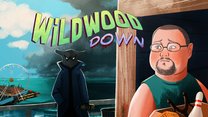



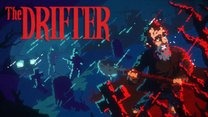




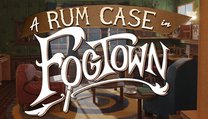
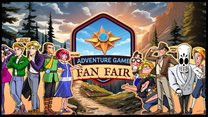
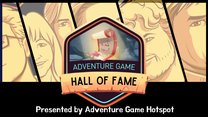

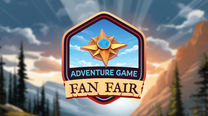

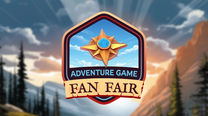
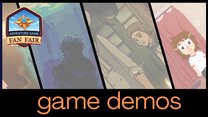

0 Comments
Want to join the discussion? Leave a comment as guest, sign in or register in our forums.
Leave a comment